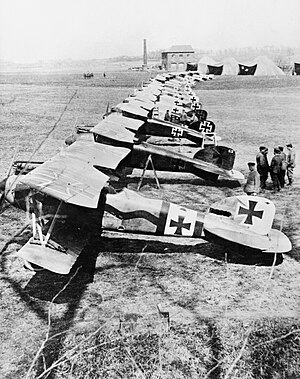Bloody April
| Bloody April | |||||||
|---|---|---|---|---|---|---|---|
| Part of the Battle of Arras | |||||||
 Albatros D.III fighters of Jasta 11. The second aircraft from the camera (with the step ladder) was painted red, and was one of several flown by Manfred von Richthofen, the most successful ace of the entire war. |
|||||||
|
|||||||
| Belligerents | |||||||
|
|
|
||||||
| Commanders and leaders | |||||||
|
|
|
||||||
| Strength | |||||||
|
|
|
||||||
| Casualties and losses | |||||||
| 275 aircraft 400 aircrew (207 killed) |
66 aircraft | ||||||
Bloody April refers to April 1917, and is the name given to the (largely successful) British air support operations during the Battle of Arras, during which particularly heavy casualties were suffered by the Royal Flying Corps at the hands of the German Luftstreitkräfte.
The tactical, technological and training differences between the two sides ensured the British suffered a casualty rate nearly four times as great as their opponents. The losses were so disastrous that it threatened to undermine the morale of entire squadrons. Nevertheless, the RFC contributed to the success, limited as it finally proved, of the British Army during the five-week campaign.
In April 1917 the British Army began an offensive at Arras, planned in conjunction with the French High Command, who were simultaneously embarking on a massive attack (the Nivelle Offensive) about eighty kilometres to the south. The Royal Flying Corps (RFC) supported British operations by offering close air support, aerial reconnaissance and strategic bombing of German targets. The RFC's commanding officer, Hugh Trenchard believed in the offensive use of air power and pushed for operations over German-controlled territory. It was expected the large numbers of aircraft assembled over the frontlines in the spring of 1917 would fulfil this purpose. However, the aircraft were, for the most part, inferior to German fighter aircraft.
Crucially, British pilot training was not only poorly organised and inconsistent, it had to be drastically abbreviated in order to keep squadrons suffering heavy casualties up to strength. This was self-perpetuating, as it resulted in most new pilots lacking sufficient practical flight experience before reaching the front.
"...the worst carnage was amongst the new pilots – many of whom lasted just a day or two..."
...
Wikipedia
